The Nitecore HA11 was released in February 2023. Nitecore has been aggressively targeting the outdoor headlamp market for the past several years with the NU-series of headlamps. Unfortunately those are all sealed units with hardwired batteries. The HA11 instead uses an AA battery. On paper it does a heck of a lot of things right.
Its got all the usual features for an "outdoors" headlamp. Multiple reasonable levels of white output. A red mode. SOS, high output beacon, red flashing. And I've got to admit that the beacon/flashing modes were a big factor towards why I got this. The solid clip means that I could use it for visibility when running or biking at night.
It's also got features targeted towards the ultralight community. The traditional elastic band headstrap is replaced with a Litesmith-style shock cord mount.
Overall it offers a unique combination of features not seen in any light. I've often felt like this is something Nitecore is good at and have frequently joked that they create product roadmaps by poking random buttons in my flashlight database until they find combinations with zero results.
Did I mention its only $20? Its only $20. Its closest competitor (the Zebralight H53) is $60.
I'm not going to do a bunch of glamour shots. Nitecore's official product page has plenty. What I will give you a teardown and the most accurate performance measurements possible.
Let's start with some simple and indisputable things.
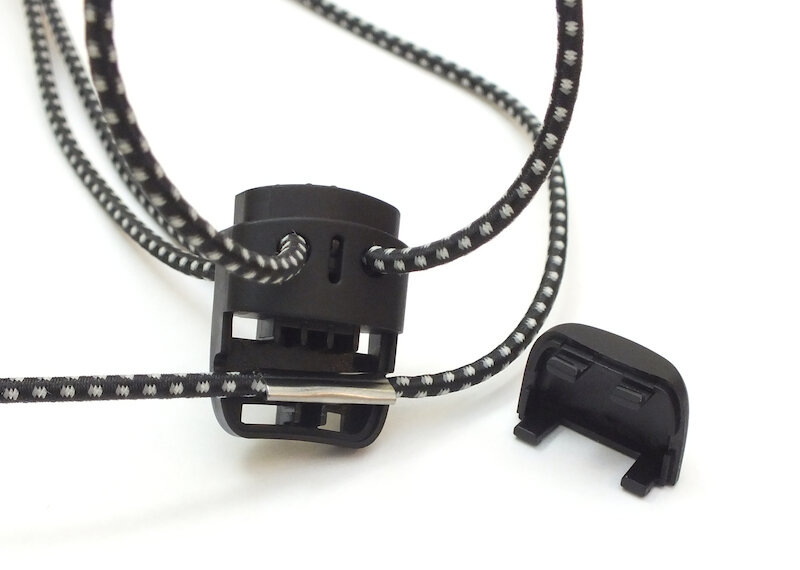
Replacing the shock cord will be easy.
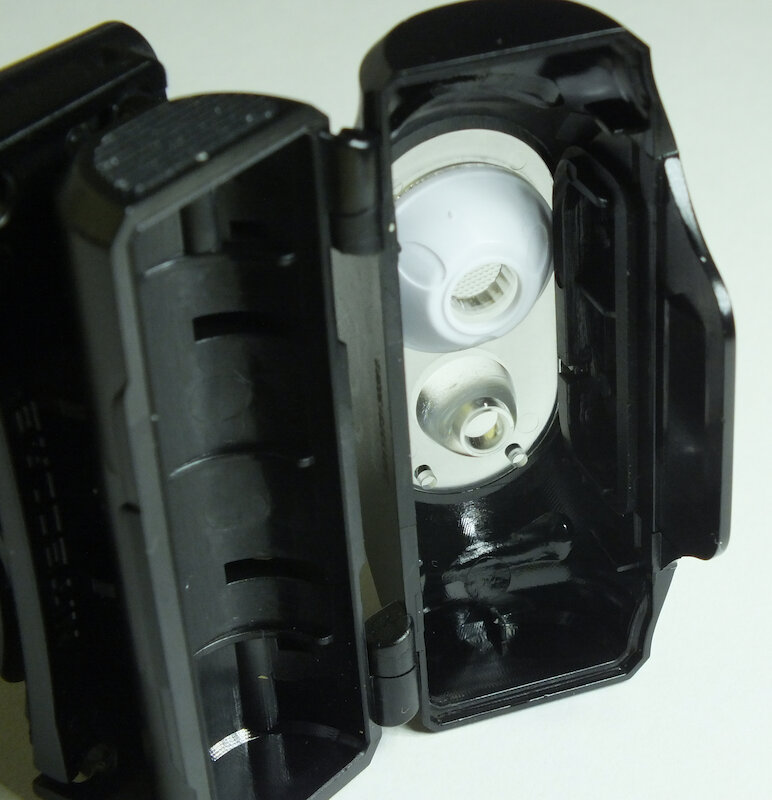
The TIRs and switch boots are all affixed.
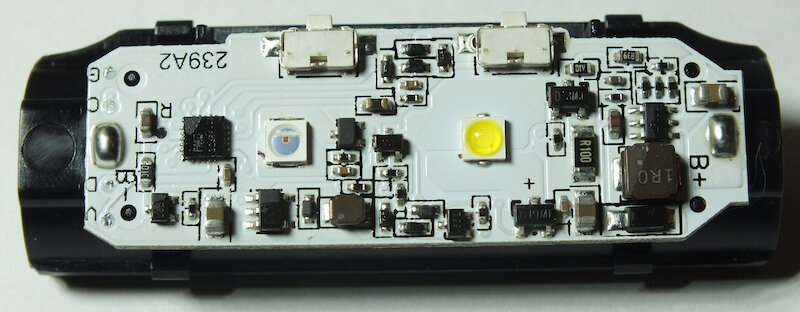
PCB closeup. Not the best soldering.
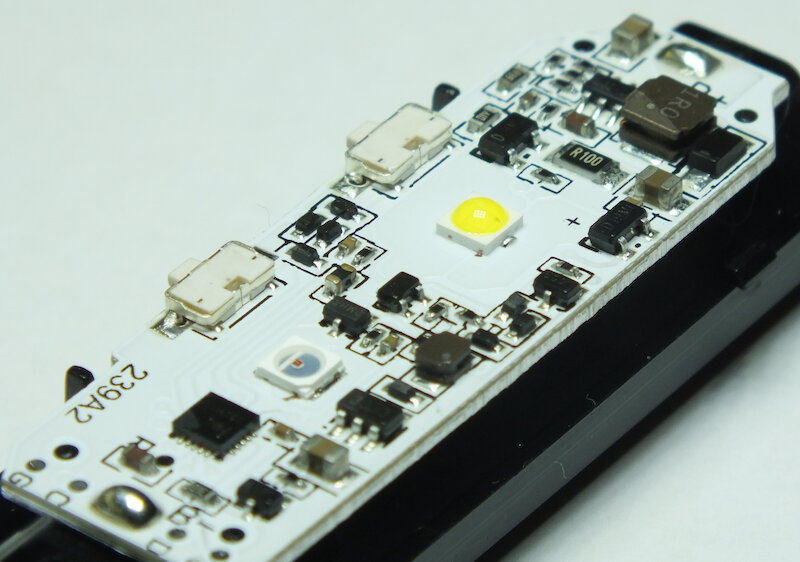
Edge of the unusual PCB.
Weights
- Empty light without accessories: 24.5 grams
- Head strap: 10g
- Clothing clip: 5g
- Light + strap + battery: 63 grams
Overall the headlamp is more stable than I expected it to be. Typically this style is much less stable than the right angle headlamps. I wasn't able to make the latch slip when it was pointing 45 degrees downward no matter how much I jumped around and tried to dislodge it.
The official instructions do not say how to get into the nice beacon modes so here are those. To access the white beacon:
- Hold the power button to turn the light on.
- 2x tap the mode button to enter SOS.
- Tap the power button to switch to beacon.
To access the red flasher:
- Hold the mode button to turn the light on red.
- Tap the power button to switch to flashing.
I am disappointed with the red light. It is a high-intensity orange-red. Far too bright and searing to preserve night vision. Its brighter than my normal indoor daytime lighting! If you wake up in the middle of the night and turn on this red light you will feel the searing pain in your eyes as all the precious rhodopsin is burned out of your retinas.
However that searing bright red means it is an excellent safety flasher. Its also useful for convincing your astronomy friends that red can hurt night vision.
Teardown
And let's also start with something I like about it. I really like how they did the shock cord. You can easily replace the cord when the elastic rots. The cord lock pops open and nothing is glued.
I also really like the construction. I was very surprised to find that the headlamp wasn't glued together. A clumsy person might accidentally tear the gasket but the headlamp pops open pretty easily. The red LED is a Lumileds Luxeon. I was not able to identify the white LED but I am pretty sure it is nothing made by any of the major manufacturers. Its a common 3535 footprint so there are plenty of options if you wanted to side-grade to something with nicer tint. The PCB appears to be laminated onto an aluminum sheet. (At least that seems more likely than using a giant MCPCB.) That construction should be pretty robust but does mean there is effectively no way for the heat to actually get outside of the headlamp.
The TIR optics are not replaceable. They are both integrated into a solid block of polycarbonate with the front window.
I am not 100% convinced that I was able to maintain full waterproofness after replacing the gasket. Its very difficult to properly seat the gasket. Be cautious if you take yours apart.
Official performance specs
All of their official performance claims are relatively bogus. To be fair this is something to expect from the "outdoor headlamp" market. See the classic Outdoorgearlab article Why Headlamp Claims are Deceptive if you haven't already. Even reputable companies feel forced to bend the truth in order to compete against the more shameless manufacturers. And boy is there a lot of bending here.
So for starters let's look at Nitecore's official numbers:
| Mode | Lumens | Candela | Hours |
|---|---|---|---|
| high | 240 | 1600 | 4 |
| medium | 60 | 460 | 10 |
| low | 6 | 30 | 40 |
| red | 5 | 15 | 10 |
It is worth noting those numbers are using an alkaline battery instead of a rechargeable Eneloop. Why Nitecore tested it that way is beyond me. Most people who prefer AA batteries use them to avoid creating e-waste. Those sealed NU-headlamps must be thrown in the trash when the battery rots out. A replaceable AA means you can just replace the worn out battery. Alkalines produce a constant stream of e-waste. Gross. And they might leak! When that happens the entire headlamp is basically scrap. More e-waste! Rechargeable NiMH AAs are the only sensible option. Plus lights tend to perform better with NiMH than alkaline. Its win-win-win.
A little background: lumens are a total measure of light. Candela is the intensity of light. Imagine a puddle of water. Lumens would be the liters of water in the puddle and candela would be the depth of the puddle. The same lumens can be focused into a small "deep" bright spot or spread across a wide "shallow" area.
Back to those official numbers. They are very fishy. Candela and lumens always scale together. Medium has 10x the lumens of low. It should have 10 the candela. Instead it goes from 30 to 360. High has 4x the lumens of medium. Candela increases by 3.5x instead. Fishy.
The hours of runtime are also screwy. A battery contains a fixed amount of energy. It can be used to make a lot of light for a short time or a small amount of light for a long time. Additionally that process is constrained by physics.
Batteries are actually a lot like planning your menu for a hike. Imagine if you saw a protein bar for sale which weighed 100 grams and made the claim "1 bar will feed you for the entire day." You know that most protein bars are around 4 calories per gram. So a 100 gram bar has 400 calories. And that 400 calories is nowhere near the 2000 calories which you would expect for an "entire day." (And even if the bar were solid fat that is still only 900 calories.) Their "entire day" claim is impossible and borderline fraudulent.
Same here. An AA battery has about 2.8 watt-hours of energy in it. Most lights convert electricity into light at a rate of 125 lumens per watt. So 240 lumens should last about 1.5 hours instead of 4 hours. 60 lumens should last about 6 hours instead of 10 hours. Fishy! Nitecore is stepping down the output to dimmer levels in order to make those runtime numbers.
Measured performance specs
So what is the headlamp actually doing? We can measure that! But I must put in another aside here. People in the 21st century tend to think that everything can be measured and known easily with great accuracy. And in general that is true enough but it isn't the case for some things. Light is actually pretty tricky to measure. And we hobbyists are doing it on a limited budget with whatever we can afford.
What is easy for us to measure? Relative changes are easy to measure. Times are easy to measure. If a reviewer says "the output drops by 50% after 30 minutes" then you can be certain they are making an accurate claim.
If a reviewer says "the output is 300 lumens" then that is less certain. Lumens are tricky to measure. You need like $10k worth of calibrated gear to do it accurately. We are using $30-$100 luxmeters that are maybe off by 10%. This is my setup. Generally we can do order of magnitudes accurately. "Officially its 1500 lumens but I measured closer to 500 lumens" is probably trustworthy. If they say "Its 523 lumens" then they are more confident about their abilities than they deserve to be.
Once again though: proportions and times will generally be accurate. I am very sure about the size and timing of these stepdowns. I am less certain about my exact lumen measurements. My numbers might be running hot by about 15%.
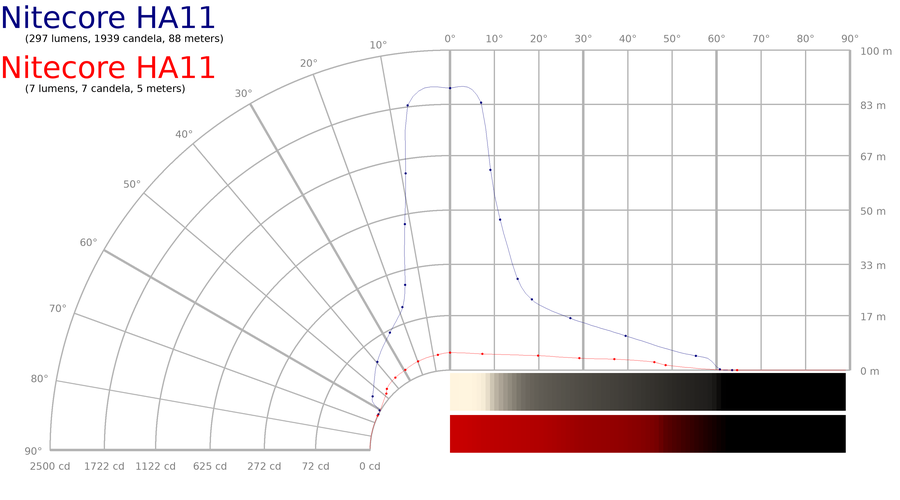
The exact beam patterns.
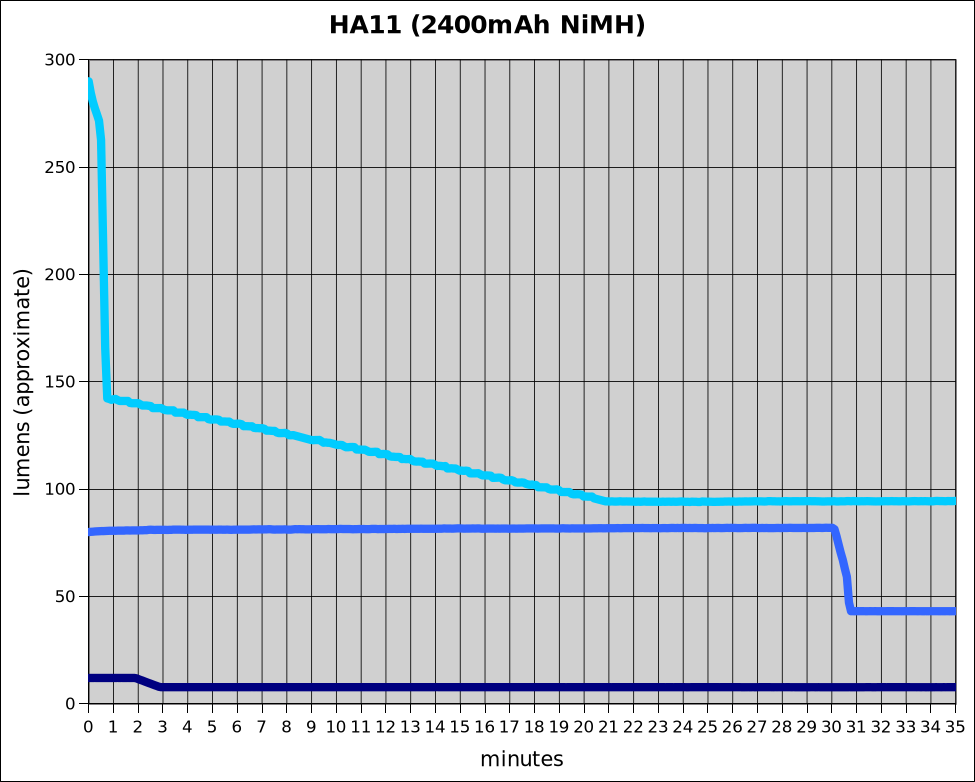
High, med, low stepdowns.

Full high runtime. Click for closeup of stepdown.

Full medium runtime. Click for closeup of stepdown.

Full low runtime. Click for closeup of stepdown.

Full red runtime.
High: It starts at about 290 lumens. Over the next minute it quickly drops down to 140 lumens. So its at 50% output now. That isn't low enough! For the next 20 minutes it slowly tapers down to about 95 lumens or 30% output. The taper is likely too gradual for you to notice by eye. It then holds 30% output for an hour. That still isn't enough! There is another gradual 20 minute taper to about 60 lumens (20%). It sustains 20% output for about 5.5 hours. At this point the battery is nearly dead. So it drops down to 8 lumens and gets you about 30 minutes of emergency runtime from the dying gasps of the battery.
Medium: It starts off around 80 lumens. It holds this for 30 minutes with some insignificant drift. Then it quite suddenly drops to around 45 lumens (55%). It holds 45 lumens for the next 6 hours. Next there is another gradual taper down to 30 lumens (35%). It holds this fairly steady for another 6 hours. Finally it drops down to 8 lumens for 20 minutes before dying completely.
Low: I had high hopes that maybe just maybe this most would be flat and honest. But its not. It begins at 12 lumens and holds that for just 2 minutes. Between 2 and 3 minutes it will gently taper down to 8 lumens (66%). It then proceeds to hold this for a whopping 50 hours.
Red: Colored modes are very tricky to measure with a common luxmeter. You really need a spectrophotometer to do it accurately. So I won't even bother mentioning the red lumens I measured. What I can say with certainty is that it very gradually drops to 75% output over the course of 3 hours. And after 18 hours hours it finally dies. That is almost 2x as long as the official runtime!
All of these stepdowns are based on timers. (Except for that final 8 lumen limp-home level.) This means that ever time you change modes or turn the light off and on the timers will restart. Let's say you are using the middle mode a bunch. And you want to conserve battery power. Officially it says 10 hours of runtime. So you plan to use it in 30 minute bursts with 30 minutes off. That should 2x the runtime right? Not with these timed stepdowns. The light will operate at full blast each time it is turned on. And (roughly speaking) that means it will be dead after 4 hours of total use. (Or 8 hours of half-on-and-off.) That is less than the 10 hours claimed or the 13 hours that I measured.
Now this isn't always bad. I rather like that the high mode only lasts 30 seconds. Typically I only need full power for about 30 seconds anyway. Typically it will be for a brief purpose. Like spotting a distant trail blaze. Or checking for any dangerous branches above the tent site. That said Black Diamond's "PowerTap" feature is a better implementation of a short full-power blast.
Is it better than the Zebralight H53?
No not even close. The ZL has best in class runtime. It can do an honest 56 lumens for 8.5 hours from a single AA battery. If you have the budget for a Zebralight I highly recommend it. Don't let the lack of red put you off. The 0.06 lumen ultralow mode is far better at preserving night vision than HA11's 5 lumen blowtorch. And the Zebralight can sustain that mode for over a month!
Want to do your own data-driven reviews?
You can! I go overboard but it can be very easy with the CeilingBounce Android app created by a /r/flashlight moderator. Here is the whole process:
- Install the app.
- Plug your phone it so it stays on.
- Start the app.
- Put the phone in a box.
- Turn on the light you are curious about.
- Put the light in the box.
- Close up the box.
- Wait for the light to run out of juice. Take a nap. Pass some time.
- And you'll have a nice runtime graph showing the stepdowns and real battery life.
If enough of us do this then maybe manufacturers will stop exaggerating their performance numbers? We can only hope.